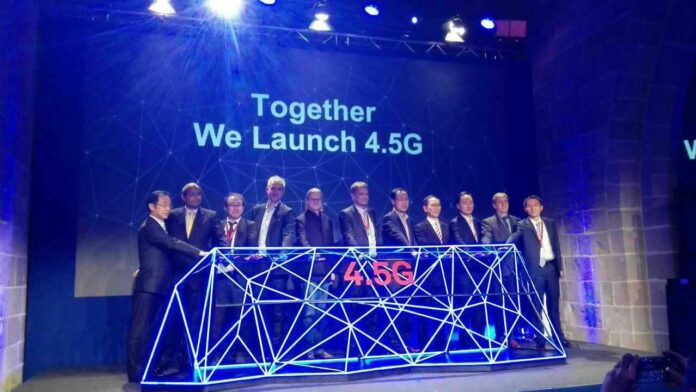Huawei hosts first ever 4.5G Summit ahead of Mobile World Congress
BARCELONA, Spain – While much of the discourse in the telecom industry is currently focused on “5G,” Chinese vendor Huawei is pushing for deployment of its so-called “4.5G” solutions as a way to extend the utility of existing LTE networks while building a bridge to an ultimate 5G standard.
Huawei initially unveiled the technology in Dubai in 2014, and in December 2015, Huawei and TeliaSonera Norway demonstrated the technology over a live commercial network in Oslo using spectrum in the 800 MHz, 1800 MHz and 2.6 GHz bands.
Based on 3GPP’s LTE-Advanced Pro standard, 4.5G includes machine-type communication enhancements, public safety features, small cell dual-connectivity and architecture, carrier aggregation enhancements, interworking with Wi-Fi, licensed assisted access in the 5 GHz band, 3D/FD multiple-input/multiple-output, indoor positioning, single cell-point to multi-point and other features meant to reduce latency and increase throughput.
“In 2016, this will be an incredibly important year for 4.5G,” said Rajeev Chand, managing director and head of research for Rutberg, adding the group of industry representatives on hand in Barcelona need to work together to “understand the path and collaboration to make 4.5G an extremely important part of our near-term future.”
Huawei has high expectations for 4.5G in 2016 as well. The company expects to reach 60 commercial network deployments by the end of the year, according to Quiu Heng, president of wireless network marketing operation.
“We are seeing that operators across all regions are interested in the deployment of 4.5G solutions,” Heng said. “We have already started negotiations with some mobile operators for the commercial deployments of 4.5G technology. We believe that this technology will explode in 2016 and that the commercialization of 4.5G will be global.”
Ryan Ding, Huawei’s president of products and solutions, emphasized that LTE is just that, an evolution.
“Today, we have our first summit because we want to work together with our industry partners to truly have a long-term evolution of our 4G, but, in the meantime, we’ve recognized before 5G comes – our market and the business – we have huge change in the next five years,” Ding said.
By 2020, Ding predicts there will be 6.7 billion users connected to mobile broadband networks; average data use will hit five gigabytes per month; and three billion things will be connected.
“All of this big change is empowered by the big data and cloud computing,” Ding added. “When we talk about big change, a huge change of the market and the business, we should also change the mindset of how we provide the network.”
Ding said instead of network-centric approach to deployments, operators should take an experience-centric approach to customers, and that 2K and 4K video, as well as other next-generation applications and services, cannot be supported by current network infrastructure.
“Looking to the future, I believe all the network should start from the experience of the people and of the things,” Ding added. “After we define the experience, then we could work together to define the network architecture, and then we develop the product.”

